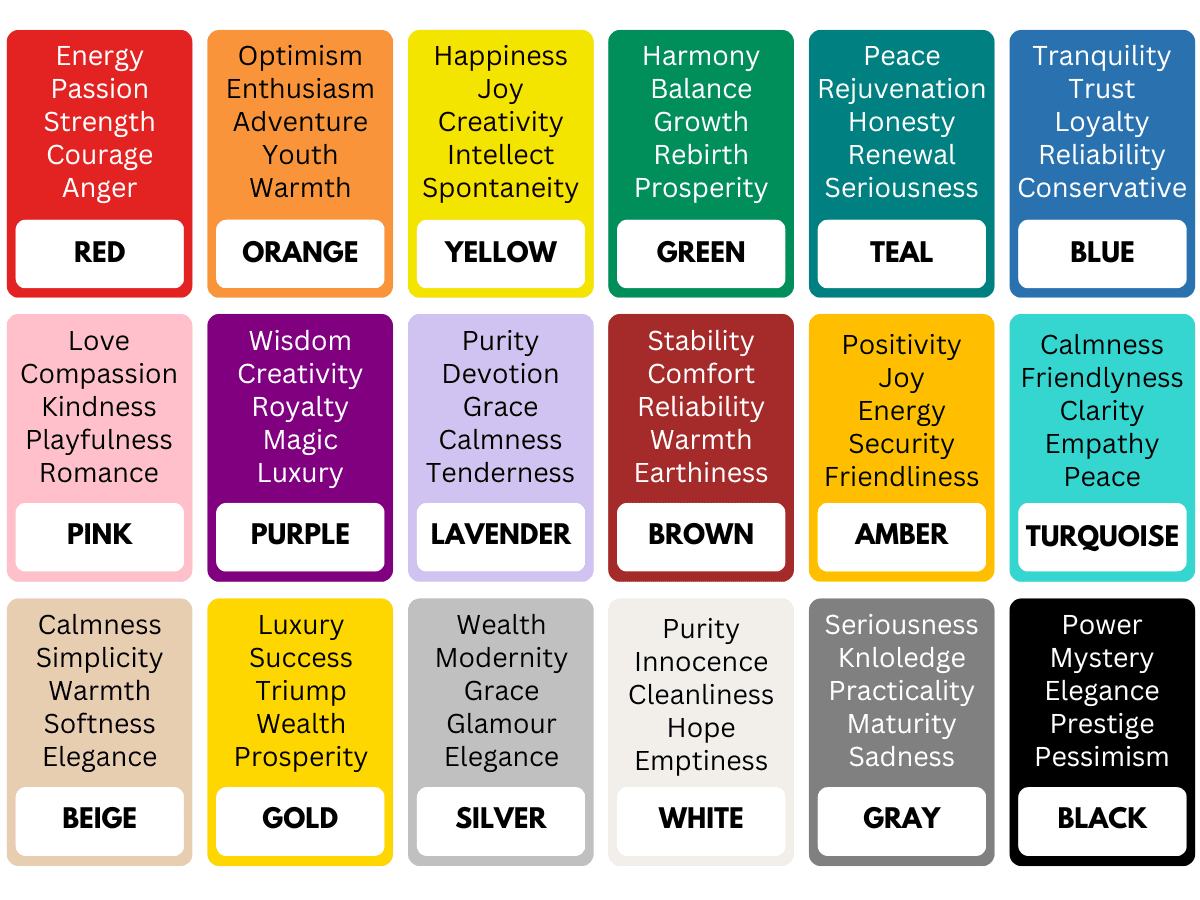In this article, you will learn about color meanings and how color symbolism impacts them. You’ll also learn what colors mean in different cultures.
Colors play an important role in our lives, influencing our moods, perceptions, and emotions. Colors have symbolic meanings that vary depending on the physiological response, cultural context, and personal experience.
Color meanings are influenced by color symbolism. Color meaning refers to the objective significance of a particular color. Color symbolism, on the other hand, refers to the subjective or culturally-specific meanings that people assign to colors.
These meanings may be based on religious, historical, or cultural associations and vary widely across cultures and periods. For example, white may be associated with purity and innocence in some cultures, while in others, it may be associated with mourning and death.
Furthermore, there are several color emotions based on people’s subjective associations with different colors. These are influenced by cultural beliefs, personal experiences, and how the brain processes color information.
Let’s find out more about the meanings of colors.
Where Do Color Meanings Come From?
The color meanings have different origins. For example, the meanings of some colors are inspired by nature, such as green, which symbolizes freshness, nature, and growth.
At the same time, some associations come from the difficult environments faced by people in certain periods, such as the association of green with poison, which originated in the 18th century from the green dye containing arsenic. However, this association is temporary and has only been attributed to that unfortunate period.
Thus, the color meanings can evolve from one period to another. The best example is the association of green, which once stood for the color of poison. Today it represents freshness, rebirth, growth, and vitality. Nowadays, we see many organic brands associated with this color.
In addition to the influences of specific historical periods, many cultural influences have contributed to the meanings of the colors.
For example, orange symbolizes prosperity and happiness in China and Japan. On the other hand, red is the color of mourning in South Africa, while in Western cultures, mourning is associated with black or white.
Color combinations can also create new meanings. For example, black and white can illustrate cleanliness and luxury, while the combination of brown and pink brings to mind sweets or candies.
Thus, many factors contribute to the way we perceive colors. These include:
- shade, tone, or tint
- color combination
- color saturation
- the proportion of colors used
Color Meanings
Let’s explore the meanings of colors in more detail.
Red
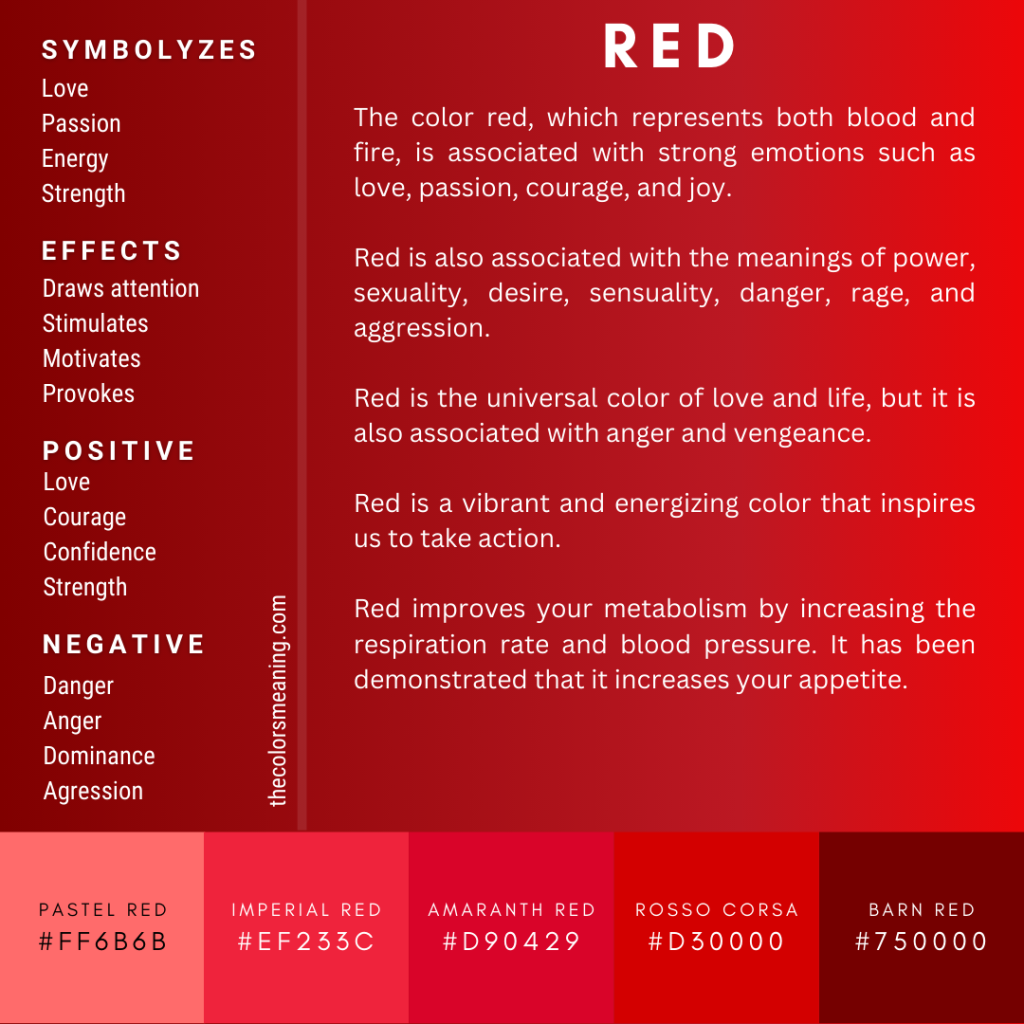
Red is an intense color with various symbolic meanings in different cultures, such as passion, love, courage, vigor, energy, anger, danger, or aggression.
The color’s symbolism is related to blood. When we are angry, we turn red in the face because our blood pressure increases.
Other factors, such as emotions, certain medical conditions, or hot weather, can also cause facial flushing. For example, when the weather is hot, our bodies produce sweat to cool down.
However, in some cases, this sweat can cause the blood vessels in the skin to dilate, which can cause the face to appear red or flushed. This is known as facial flushing or erythema, a natural response to heat and physical exertion.
Because it is associated with passion and anger, red can also symbolize aggression. The physiological effects of the color red, such as increased heart rate and respiration, may also contribute to its association with arousal and aggression.
Red can also symbolize danger. This is why it is used for stop signs, alarms, or high temperatures.
Read more about the color red.
Orange
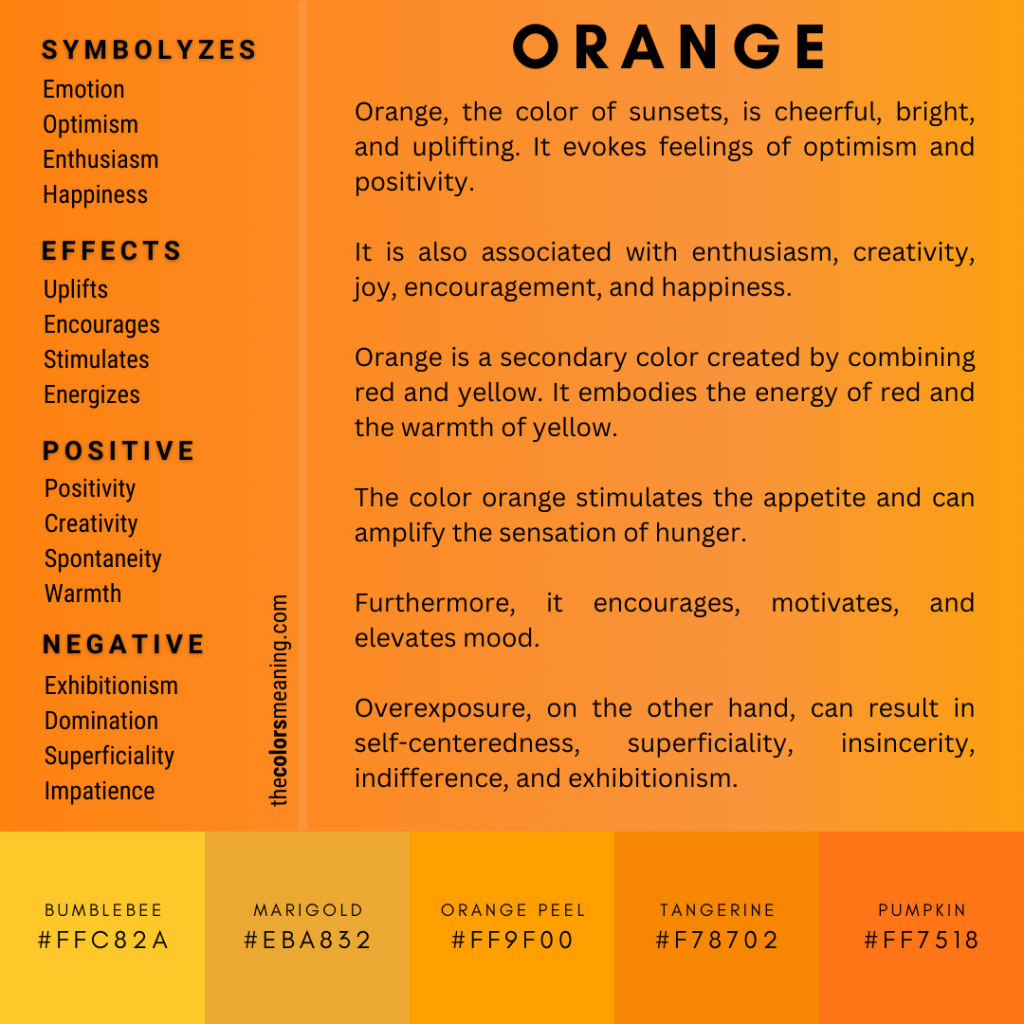
Orange looks a lot like red, but it’s more subdued. So the meanings of the color are associated with energy, enthusiasm, optimism, warmth, and youth. It is less energetic than red but more enthusiastic than yellow.
It also combines red’s warmth and energy with yellow’s joy and playfulness.
Many brands use orange to convey a message of optimism or extra energy. It also helps keep audiences excited. What’s more, it’s an excellent attention-grabber.
On the other hand, the color’s meanings also include impatience, deceitfulness, immaturity, and superficiality.
Read more about the color orange.
Yellow
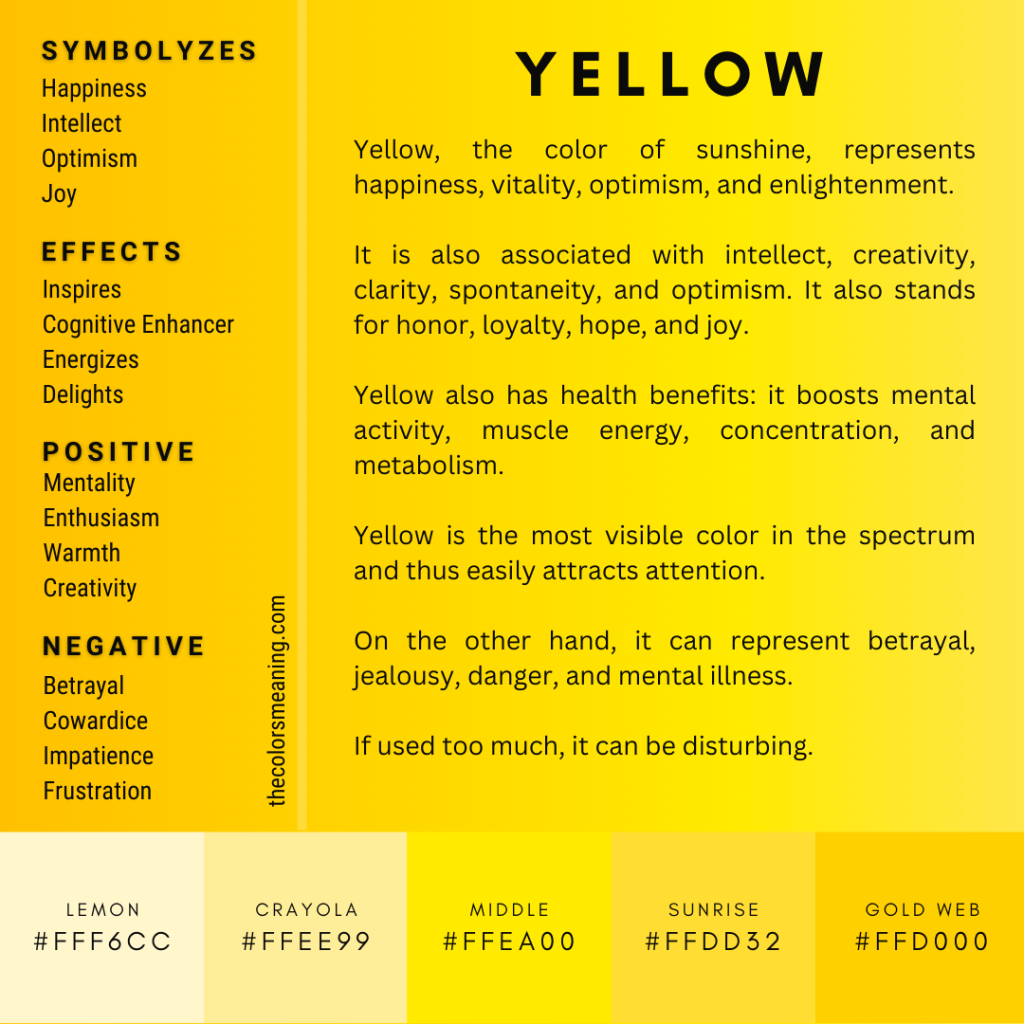
Yellow is the vibrant color associated with sunshine and happiness. This color has a range of symbolic meanings in different cultures, including cheerfulness, happiness, optimism, and friendship.
Yellow also stands for intellect, creativity, and spontaneity.
Moreover, yellow attracts attention and conveys hope, brightness, and positivity. At the same time, it can signify caution.
In some Asian cultures, for example, yellow is considered a sacred color associated with wisdom, spirituality, and enlightenment.
But the symbolism of the color differs from culture to culture. In Latin America and the Middle East, yellow is associated with mourning, but in Africa, it signifies wealth. In Western cultures, it is the color of fun and joy.
Negative meanings of the color are linked to cowardice, egotism, caution, or deception.
So, when using yellow, knowing your audience’s country of origin is essential.
Read more about the color yellow.
Green
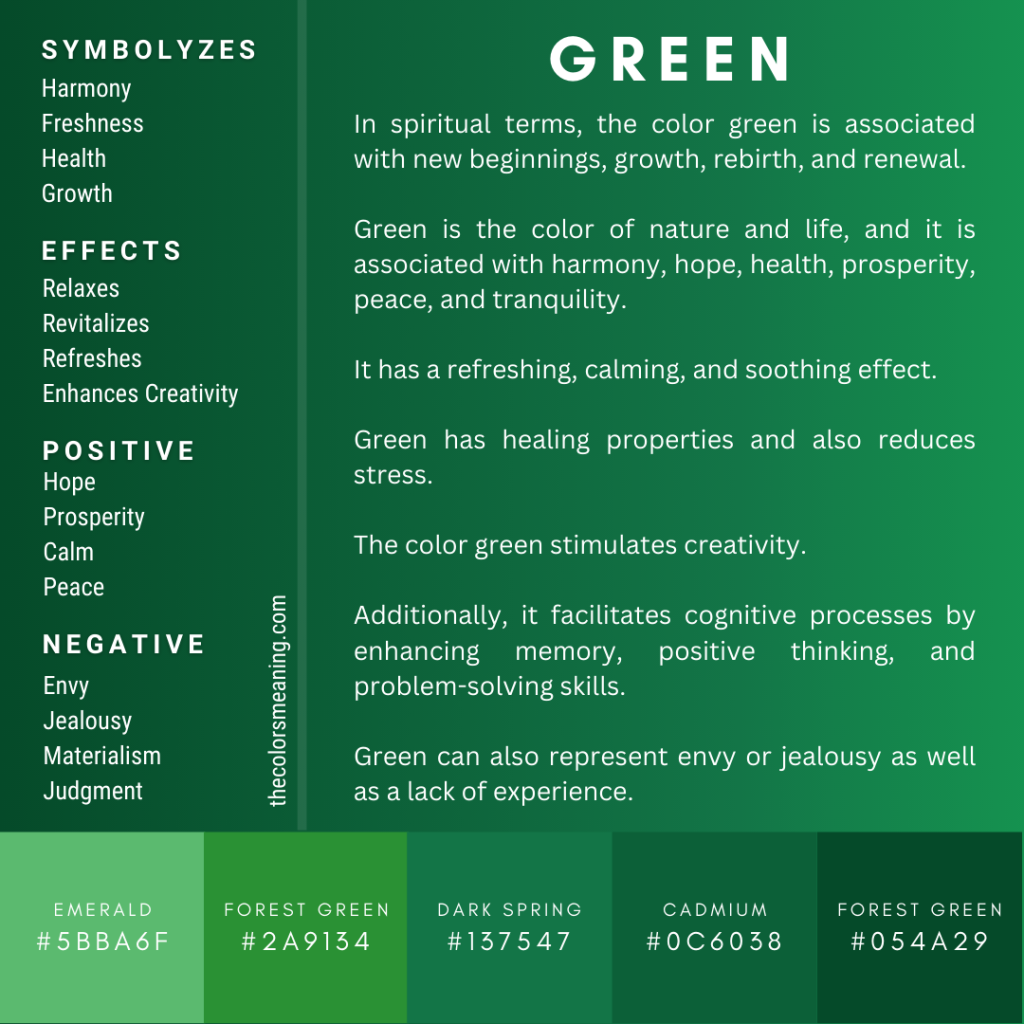
Green is a hue whose meanings are inspired by nature. It is associated with growth, freshness, new beginnings, and rebirth. Moreover, it has a revitalizing effect on the mind and body.
It is also a peaceful color that stands for sustainability, harmony, generosity, and balance. So if you have a brand that values health or focuses on healthy food, using yellow in your branding is a great idea.
Because it is closely linked to nature, people tend to associate green with organic or eco-friendly products.
Interestingly, green incorporates the calming effect of blue and the energy of yellow. Thus, it has a harmonizing and balancing effect.
In some cultures, it symbolizes success, wealth, prosperity, and abundance. This symbolic association comes from the USA, from the color of money.
The negative meanings of the color are related to envy, jealousy, greed, and materialism. It can also be associated with illness because when we are sick, we tend to have greenish skin due to the lower amount of hemoglobin in our blood. This compound gives color to the red blood cells.
Read more about the color green.
Turquoise
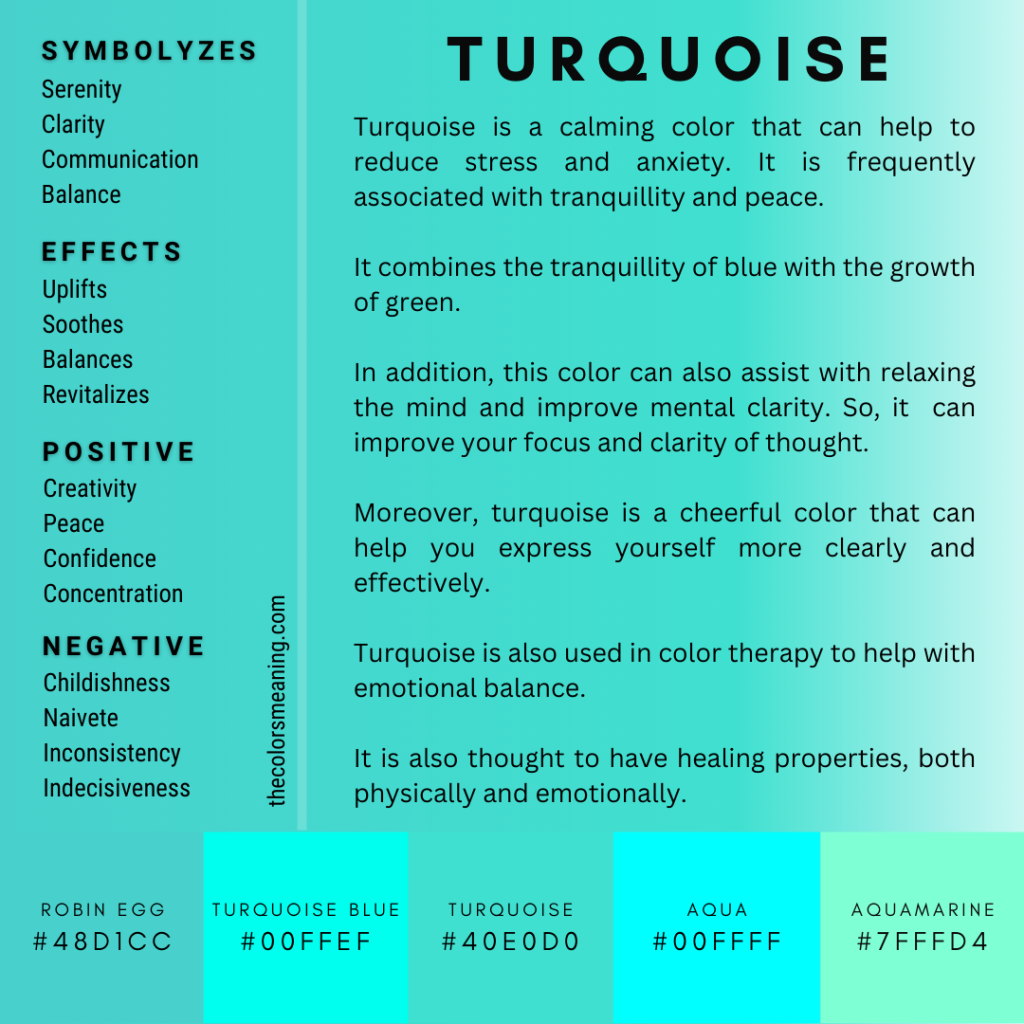
Turquoise, a shade of blue-green named after the same name’s gemstone, carries many meanings, including calmness, tranquility, peace, compassion, clarity, and empathy.
Turquoise calms down, clarifies, and balances.
This color is often used in design to create a soothing and relaxing mood.
In addition to its association with calmness, turquoise is also associated with creativity and communication. It is said to promote self-expression and stimulate the imagination. In some cultures, turquoise is also seen as a symbol of healing and protection.
Read more about the color turquoise.
Teal
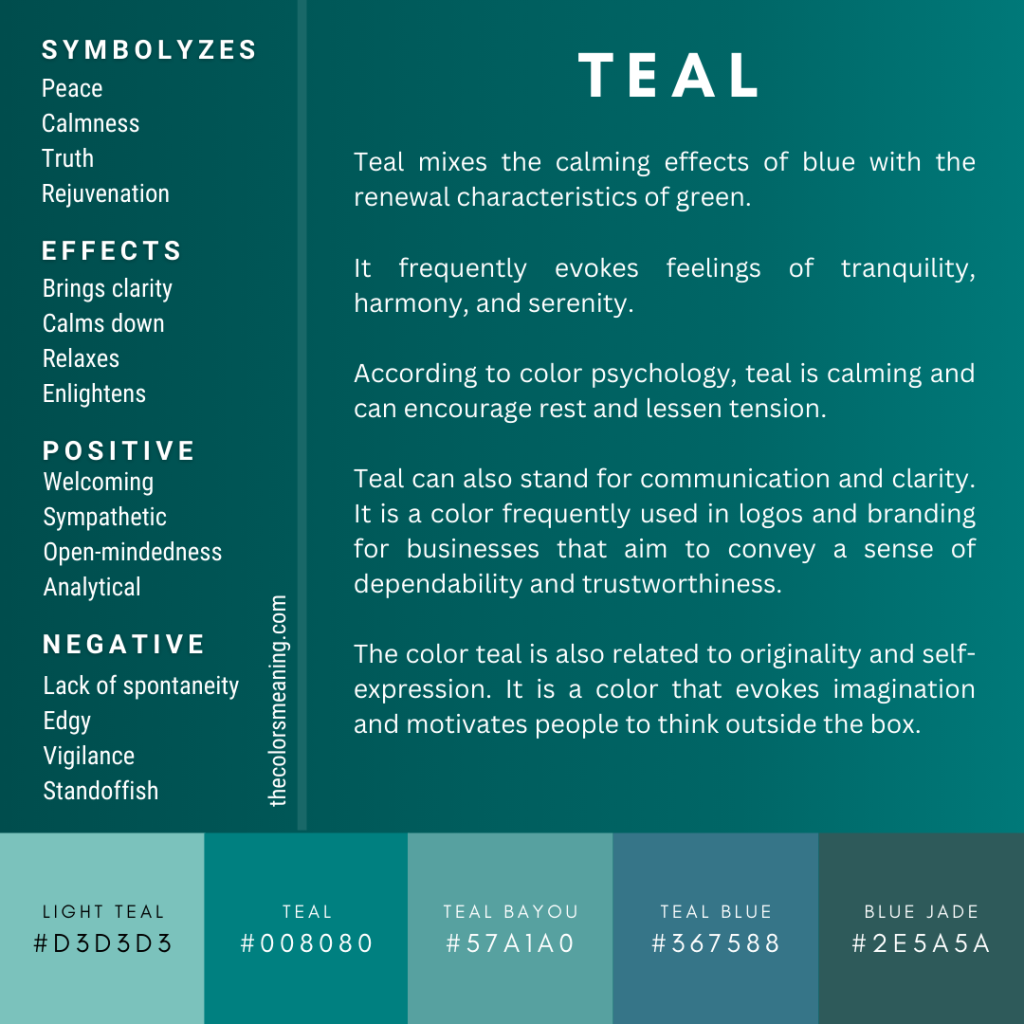
Green, a combination of the calmness of blue and the freshness of green, is associated with tranquility, balance, and stability. It is a soothing color that promotes a sense of peace and relaxation.
Furthermore, teal evokes elegance and sophistication and can be used in any design or decor to create a serene and soothing vibe.
In addition to its calming properties, teal is associated with clarity of thought and communication. It is said to aid decision-making and problem-solving and can help stimulate the mind and encourage creativity.
Teal is also associated with emotional balance and harmony and is said to help with feelings of stress and anxiety.
In general, teal is seen as a positive and uplifting color that can bring a sense of calm and clarity.
Blue
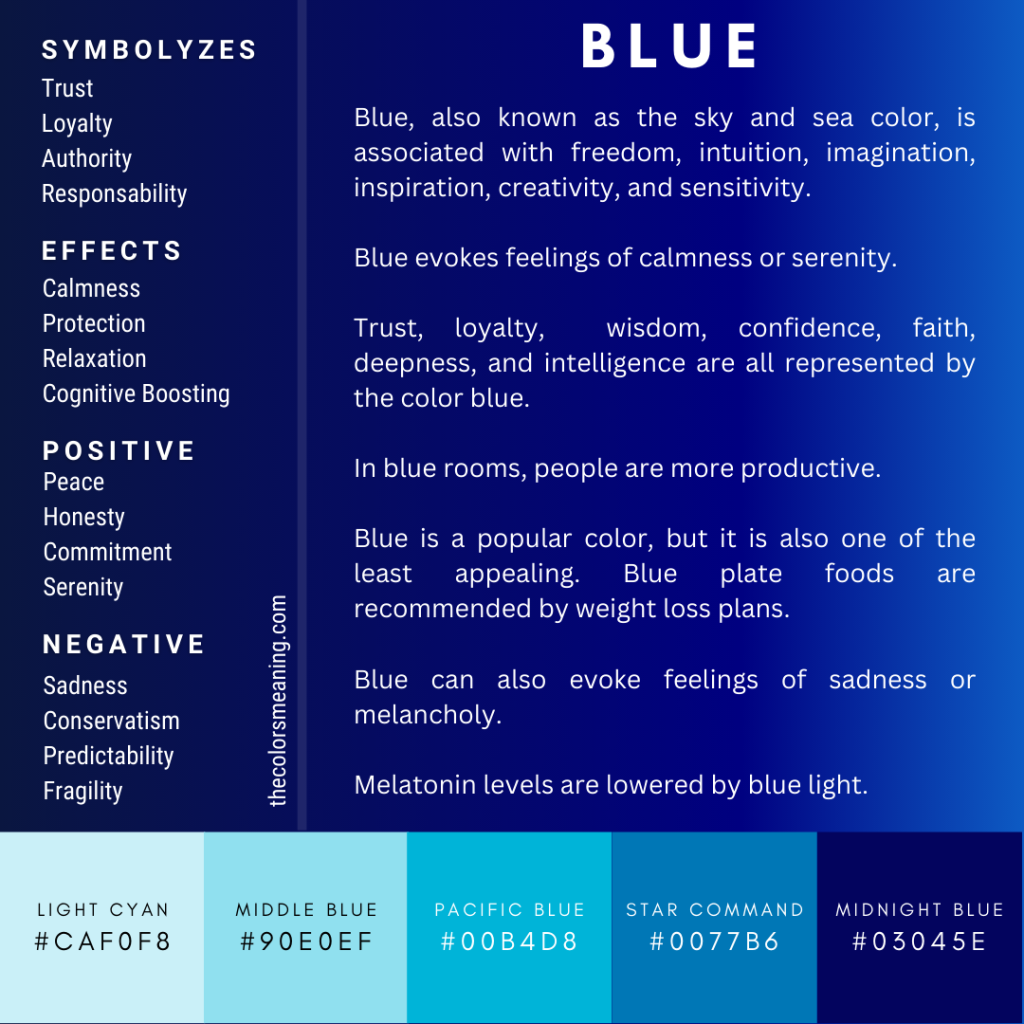
Blue, the color of the sky and the sea, is associated with tranquility and relaxation. Moreover, blue symbolizes loyalty, trust, and responsibility.
Although the coolest color that comes to mind, blue has spiritual associations in many cultures. While it is associated with the Virgin Mary in Latin America, it represents heaven in the Middle East.
However, lighter shades are more calming and relaxing, while darker tones are associated with trust and loyalty.
On the other hand, the color meanings also carry negative connotations such as sadness, depression, conservatism, and coldness.
In Western cultures, blue stands for tranquility, trust, and authority, while it can indicate mourning in South America.
Using blue in design can convey confidence and trustworthiness to the audience but can also have a calming effect. According to a study, companies that use blue in branding convey higher trust to their audience. [1]
Read more about the color blue.
Purple
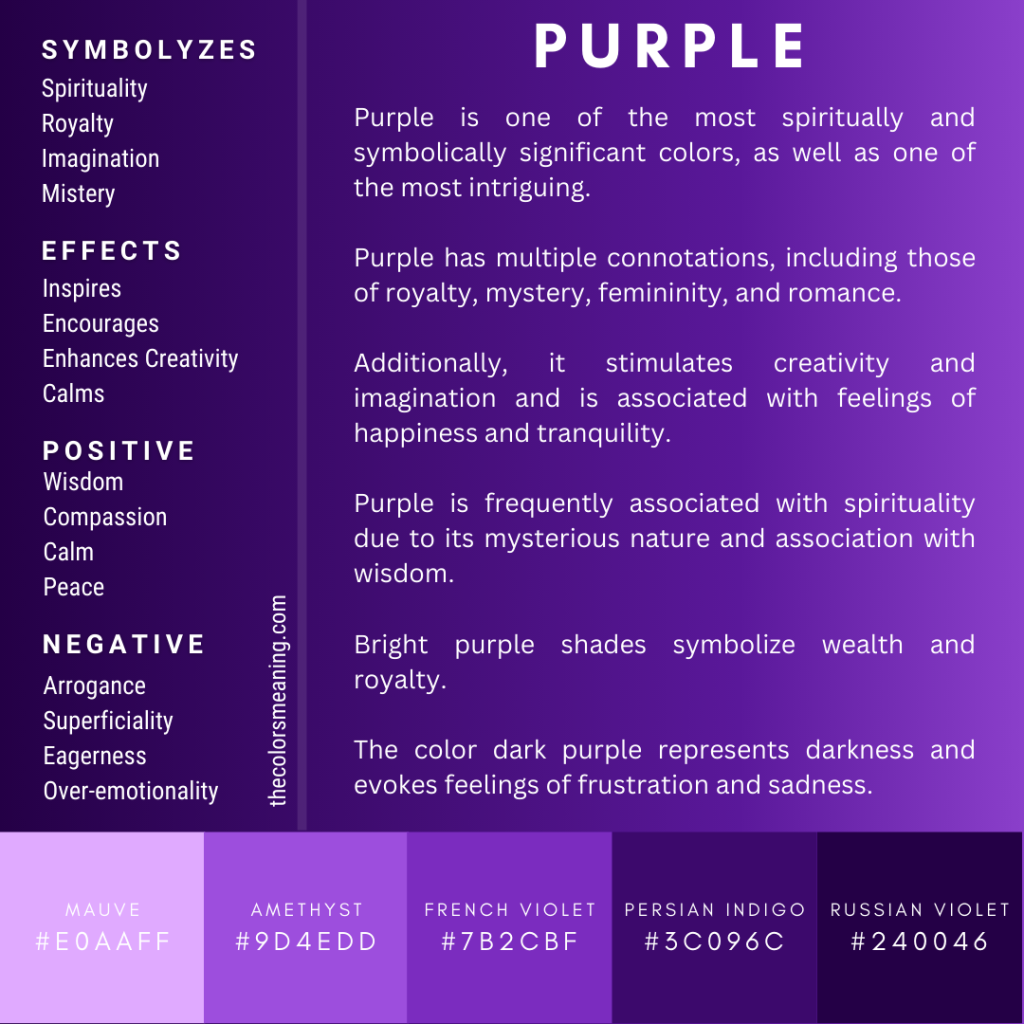
Whether you call it purple or violet, this color results from mixing red and blue. It has a wide range of meanings, including royalty, regality, luxury, creativity, ambition, wisdom, and independence.
Purple is magic. It’s sophisticated.
Purple’s connection to royalty dates back to ancient monarchies, when Tyrian purple paint was challenging to produce and, obviously, very expensive. It was made from the mucus secretion of a snail species.
It is also a color of spirituality that enlightens, uplifts and inspires. In many spiritual traditions, purple is associated with the crown chakra, which is said to govern our connection to the divine.
However, you should remember that the color’s symbolism differs from culture to culture.
In Western and Middle Eastern cultures, purple symbolizes wealth and royalty. Still, in Italy, Brazil, and Thailand, it is a symbolic color of mourning.
Because it symbolizes power, ambition, and luxury, the color’s meaning is also affected by negative associations, including arrogance, immaturity, and instability.
Read more about the color purple.
Pink
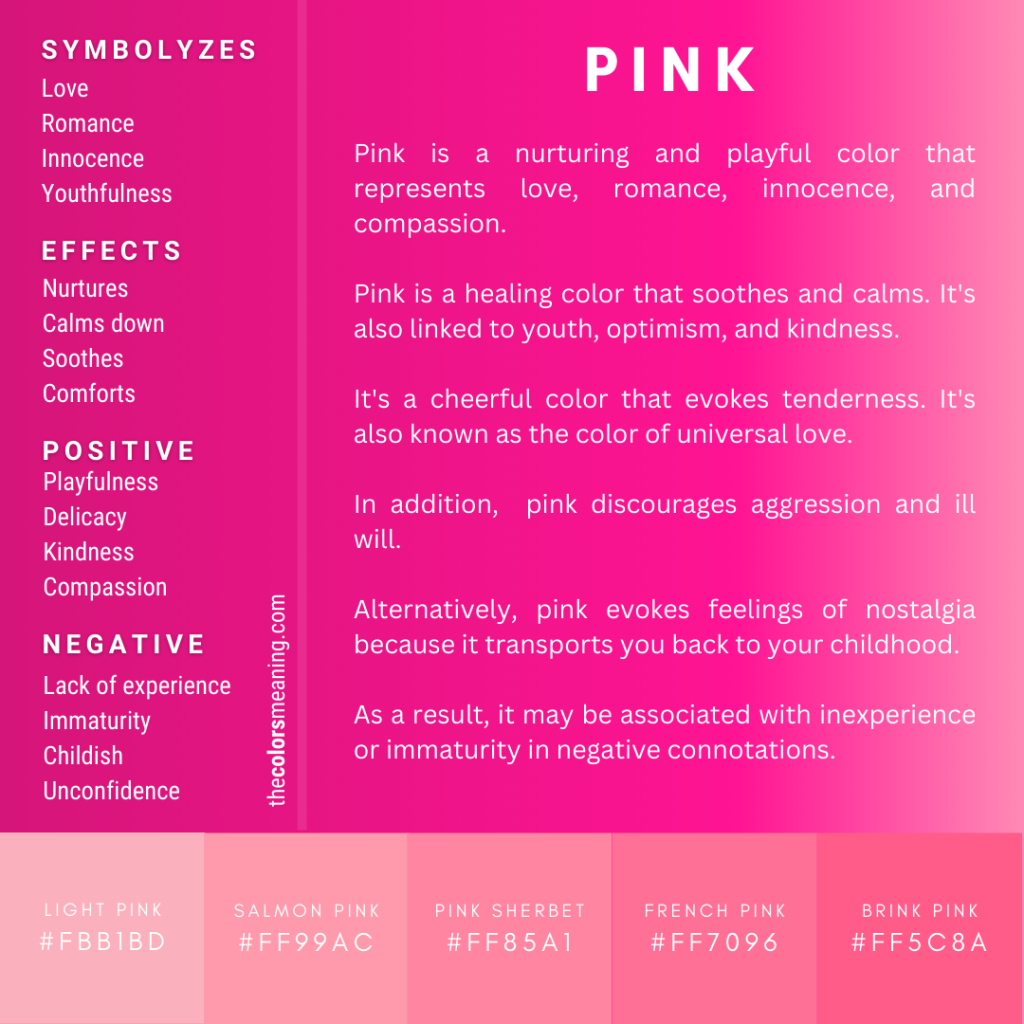
Pink is the color of romance and kindness, often associated with sweetness, tenderness, innocence, playfulness, delicacy, and femininity. It’s like a red that lacks aggression.
Pink nurtures, comforts, and calms. Yes, pink has been proven to suppress human aggression. [2] That’s why it has even been used in prisons to calm prisoners.
What’s more, it’s playful and nostalgic. Pink often takes us back to our childhood. So it really symbolizes the innocence of childhood.
So it’s a good idea to use it if you have a young audience or sell baby products. Because it is associated with sweetness, pink is often used for sweet packaging.
However, not all shades of pink have the same meaning. While bright pinks stand for love and romance, intense pinks create a sense of urgency.
If red stands for passion and love, pink is more romantic and caring.
Like any color, it has negative meanings. For example, it is associated with immaturity, lack of confidence, or a tendency to be overly emotional. Also, bright pink can symbolize unwillingness to take things seriously.
Read more about the color pink.
Brown
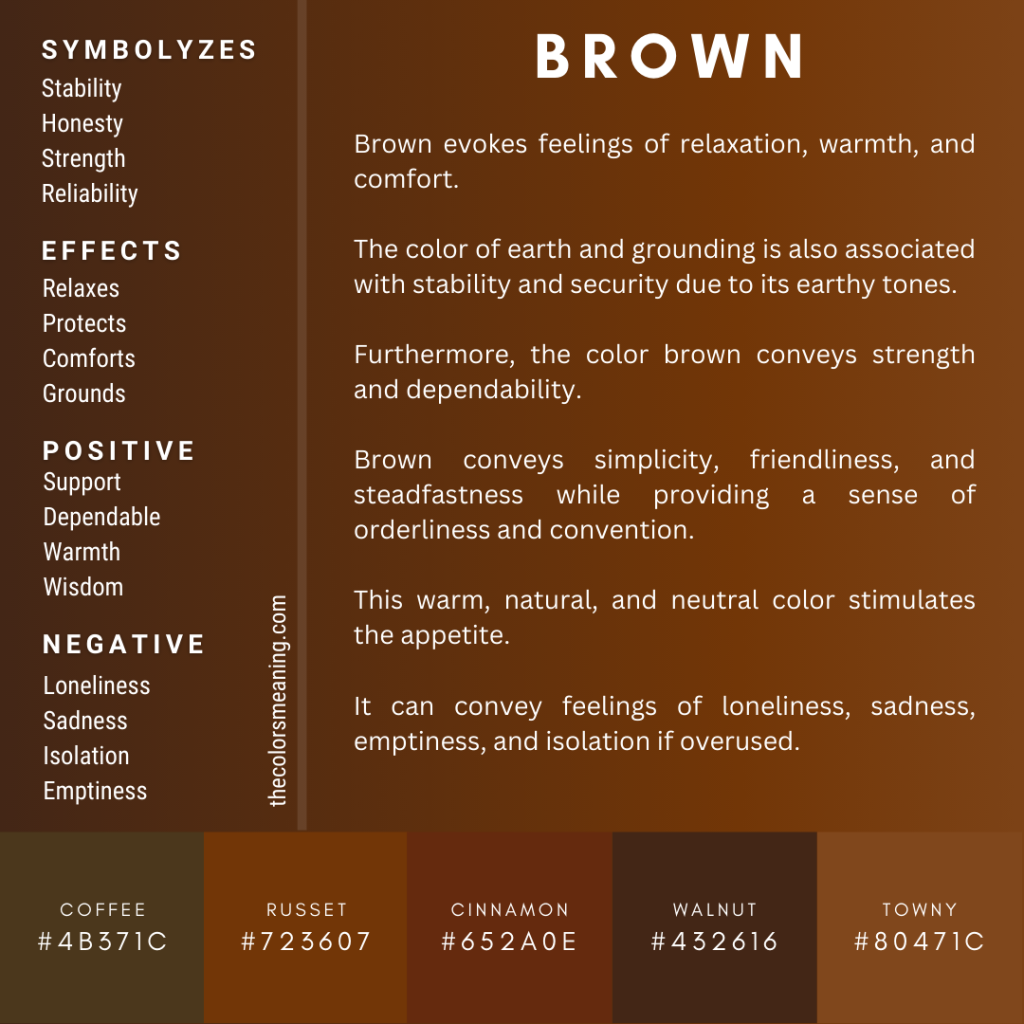
Brown is the color of comfort and simplicity.
Moreover, brown is often associated with earthiness and warmth. Brown can convey a sense of stability, security, and reliability, representing steadfastness and dependability.
It is often used in marketing to create a feeling of trustworthiness and authenticity.
Strongly linked to the earth and nature, brown can be used to promote organic and healthy products. In fact, it is the color of earth and wood.
Moreover, it can convey strength and reliability.
Brown can be seen as robust and old-fashioned, so robust and established brands use brown in their design.
On the other hand, brown can be associated with boredom, loneliness, and isolation, like the vast sands of the desert.
Read more about the color brown.
Tan and Beige
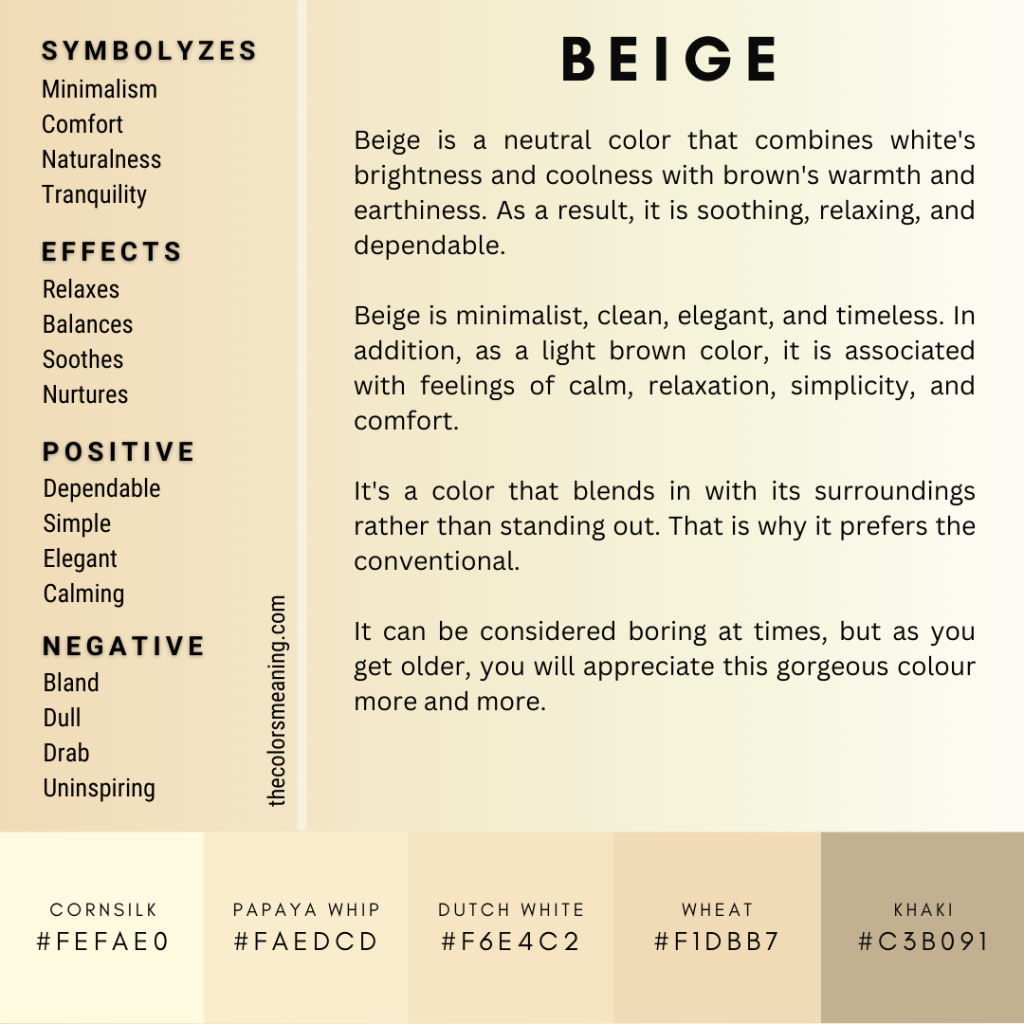
Tan and beige are neutral colors that are often associated with warmth and earthiness.
Tan, like other browns, is associated with warmth, comfort, and relaxation. Tan is also a welcoming and friendly color that has the earthy stability of brown.
Furthermore, because it can convey a sense of health and wellness, tan is frequently used in natural and organic products such as skincare and cosmetics.
Tan exudes a sense of simplicity and timelessness. Because it blends well with other colors, it is a versatile choice for many design applications.
Tan is also a practical and functional color that represents dependability and resilience.
Conversely, tan can be perceived as a color of boredom and predictability, and it may not be the best choice for brands or products seeking to convey excitement or energy.
Beige is the color of simplicity, combining white’s crispness with brown’s warmth. Beige is also associated with serenity, elegance, dependability, and softness. On the other hand, beige is sometimes perceived as conventional, dull, or even bland.
Cream and Ivory
Cream and ivory are neutral colors associated with elegance, sophistication, durability, and dependability.
Ivory is a slightly darker shade of white with a yellowish or brownish tint, whereas cream is a pale yellowish-white color. Both colors evoke a sense of history.
Compared to cream, which has more intense yellow undertones, ivory is a brighter white.
Ivory is a soothing and relaxing color associated with purity and softness.
Cream, a pastel of yellow, symbolizes sophistication, calm, elegance, and durability.
Cream and ivory are relaxing and serene, making them popular choices for any design.
Black
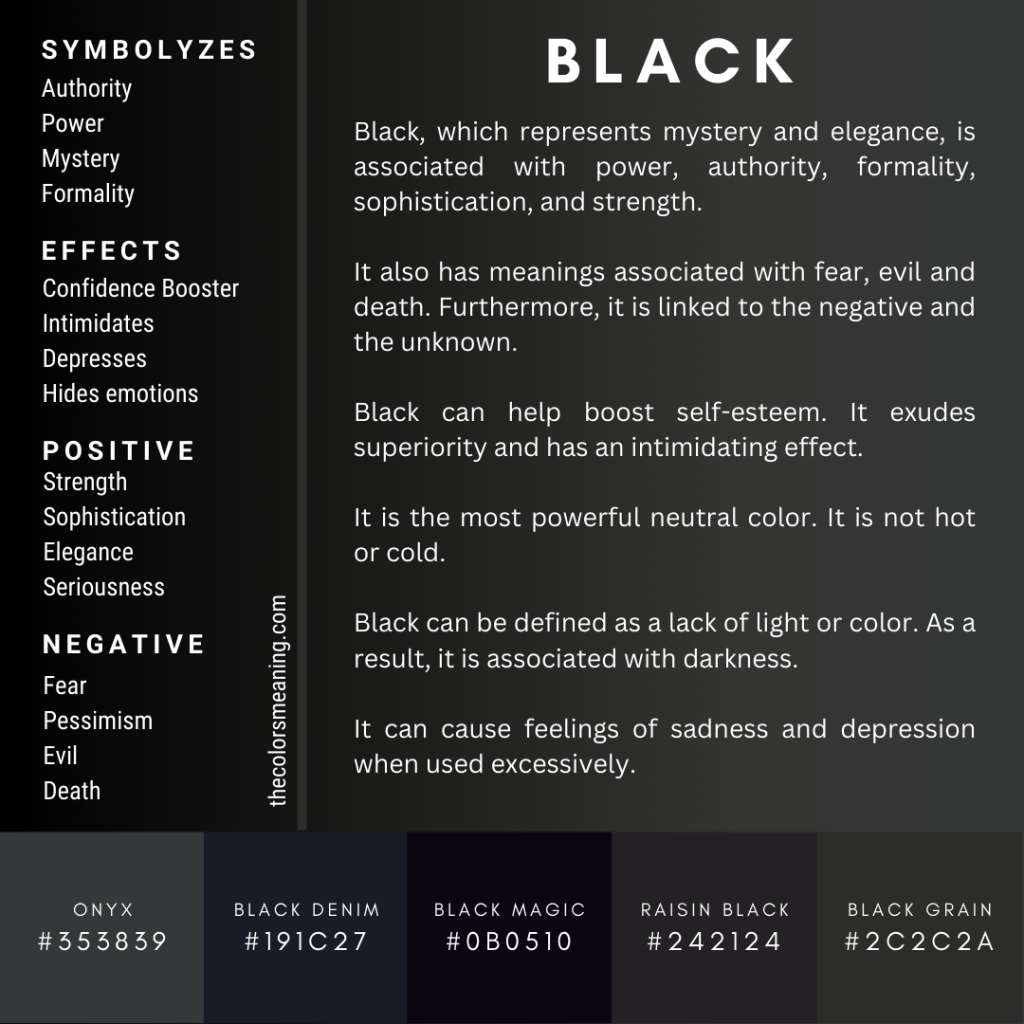
Black stands for power, sophistication, elegance, and refinement. It is connected to prestige, authority, mystery, and protection.
Black seduces and secures but also intimidates.
It is perceived as a powerful and sophisticated color that conveys elegance and formality.
Black is used for high-end products, luxury brands, and formal attire such as tuxedos and evening gowns.
When it comes to marketing, black is used to convey elegance and exclusivity. It is powerful and gives a sense of luxury. That’s why it’s so used in the fashion industry.
On the other hand, black can be perceived as sad, pessimistic, or depressive. It can also be seen as a color of death, loss, or evil.
In Western, Middle Eastern, and South American cultures, black is associated with mourning. In China, it symbolizes prosperity, while in Japan, black represents mystery.
See how the color symbolism brings different connotations?
Read more about the color black.
White
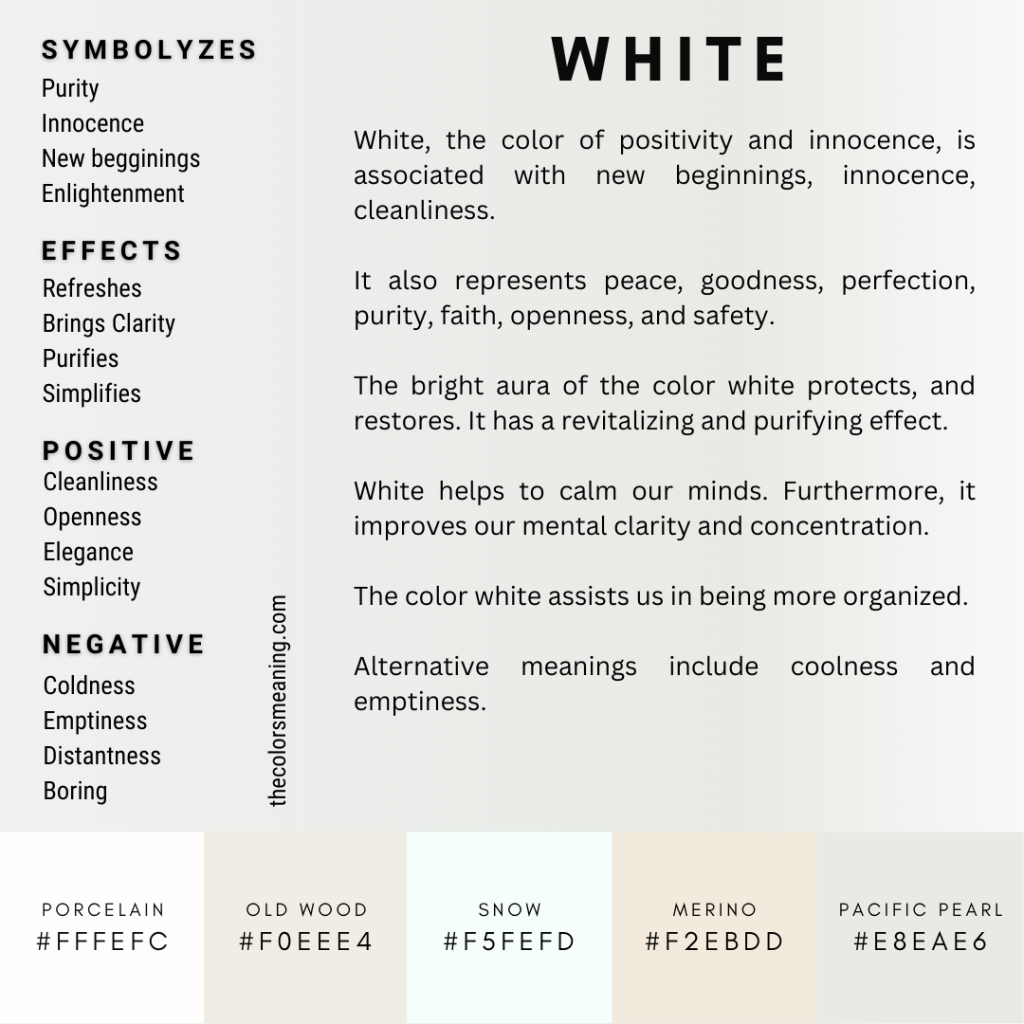
White carries meanings of purity, innocence, and cleanliness. It is the color of fresh snow, clean linen, and pure milk. White is the color of new beginnings in many Western cultures, which is why it is so used in weddings.
It is also a popular color for healthcare settings, such as hospitals and clinics, as it can create a perception of cleanliness.
White is the color of simplicity and minimalism. It is often used in modern design, such as minimalist architecture and interior design. White creates a sense of openness and spaciousness, making a room feel larger and more airy.
However, white can also be associated with emptiness and lack of emotion, as it can sometimes feel cold and sterile.
Like black, white can also symbolize grief. For example, in some Asian cultures, white is associated with misfortune, death, and mourning. On the other hand, in Latin America, this color stands for peace.
Read more about the color white.
Gray
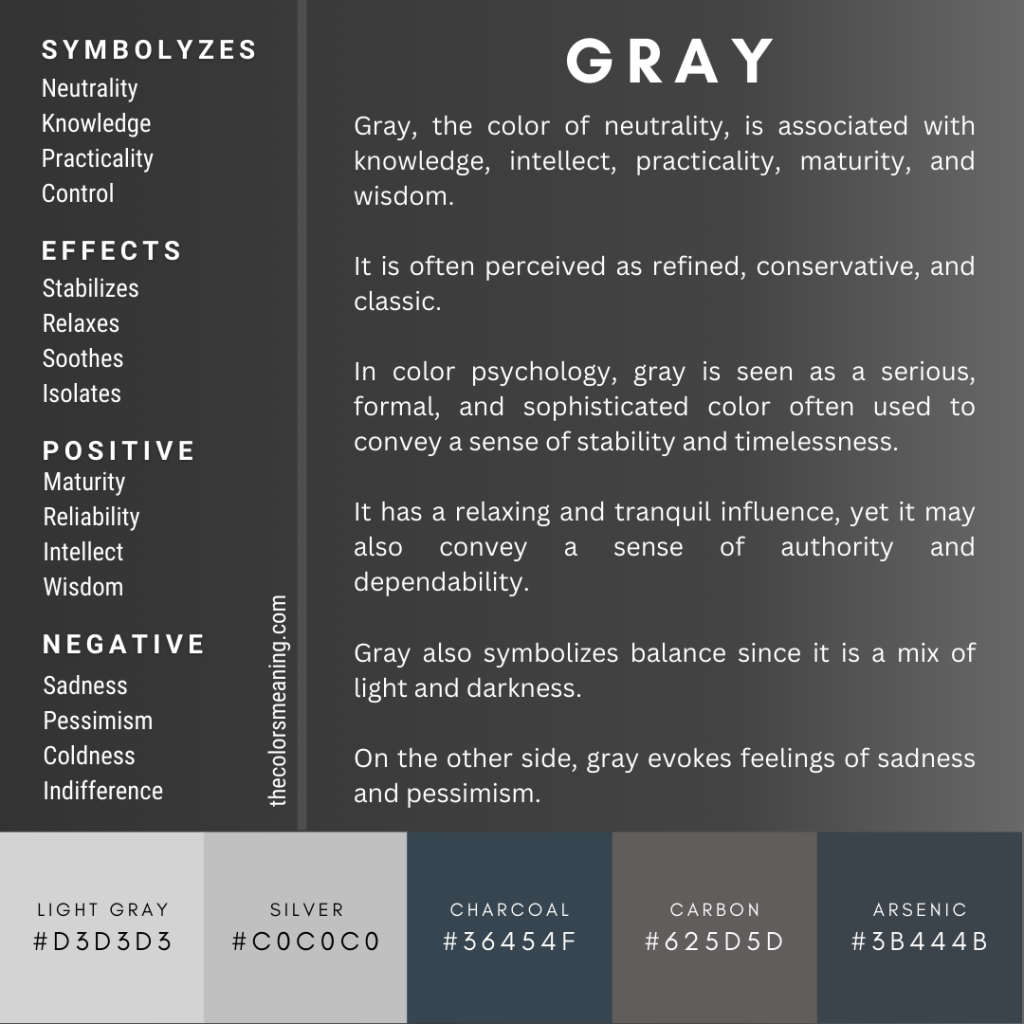
Gray is a practical and timeless color, representing stability and balance. Moreover, gray is a calming and soothing color, creating a sense of tranquility.
It is also a popular color in business settings, as it can convey professionalism and formality.
Although it may be perceived as conservative, gray is modern and sophisticated.
On the other hand, gray can also be associated with gloominess and sadness, as it is often the color of cloudy skies and rainy days. It can represent feelings of uncertainty and ambiguity, as gray can be seen as a color of compromise and indecision.
In some cases, gray can also be seen as a dull color, lacking the vibrancy and energy of other colors.
That’s why it can be perceived as depressive or moody.
Read more about the color gray.
Color Meanings Chart
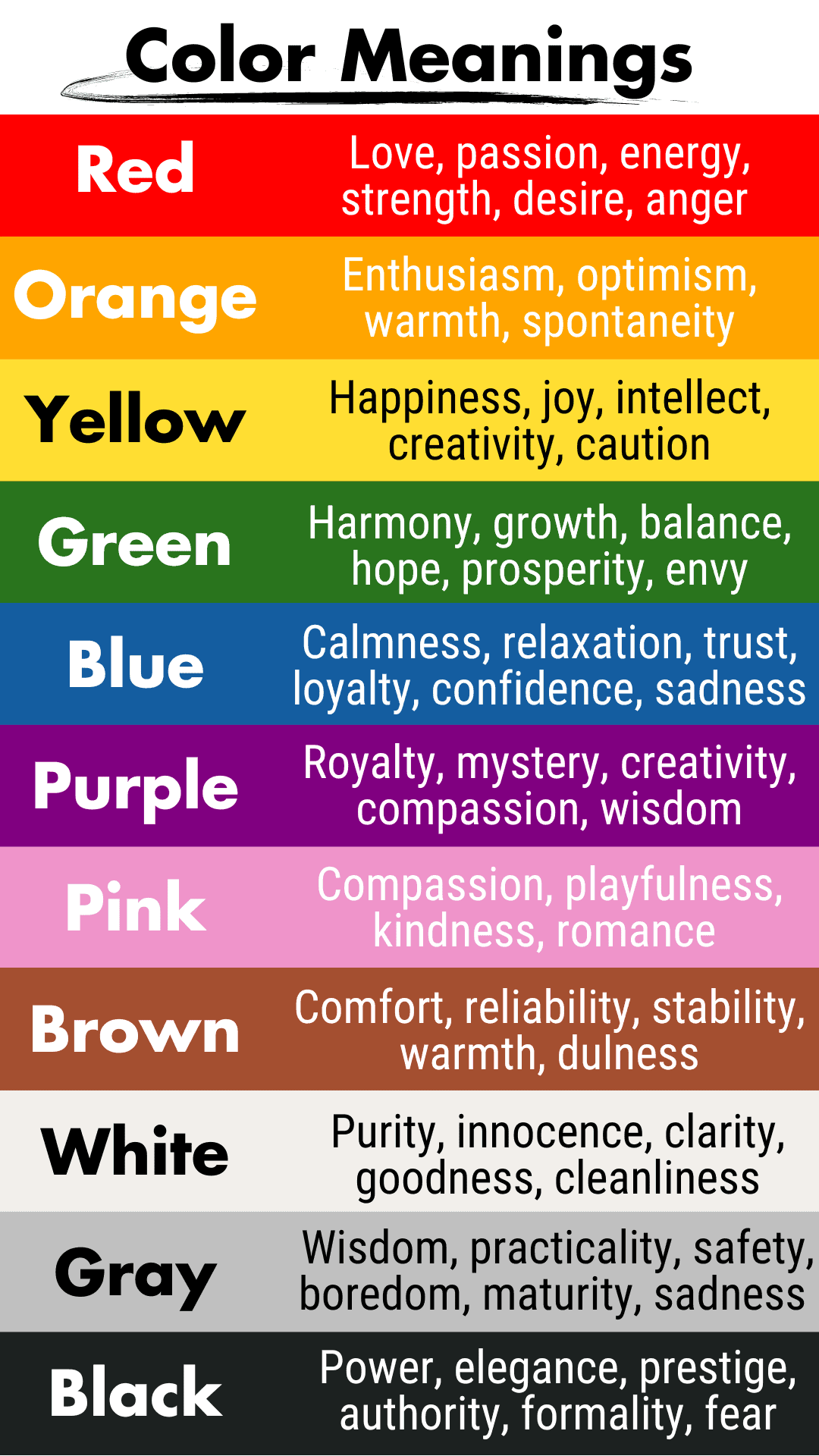
In order to embed this infographic on your website, please copy and paste the code below. Otherwise, no usage rights will be granted.
<img src="https://thecolorsmeaning.com/wp-content/uploads/2023/04/color-meanings.png" alt="color meanings" width="1080px" border="0"><small>Like this? Learn more about the <a href="https://thecolorsmeaning.com/color-meanings-and-symbolism/" rel="noopener" target="_blank">color meanings</a>.</small>What is Color Symbolism?
Color symbolism refers to the subjective meaning that people attach to colors. Thus, people assign meanings to different colors in three ways: biologically (e.g., rd = fear), culturally (e.g., black = loss or mourning in many Western societies), and personally, based on personal experience.
So the symbolism of color is quite subjective and depends on both the context and the physiological way people react to color.
Suppose the biological response is about how the body responds to color or colored light. In that case, the cultural response is about the society you live in.
For example, the biological response can be considered the physical effect following exposure to light of different colors:
- Red: increases blood pressure and heart rate, enhances the speed and strength of reactions, stimulates melatonin production, and enhances the appetite.
- Orange: increases energy level, stimulates the thyroid and boosts metabolism, stimulates the appetite, and enhances creativity.
- Yellow: gives the brain a “wake-up call,” enhances concentration, and keeps depression at bay.
- Blue: lowers blood pressure, calms down, and increases performance on attention-based tasks. [3]
- Green: boosts the immune system and stimulates the creation of growth hormones.
- Purple: reduces emotional and mental stress.
- Pink: calms down.
Color Symbolism in Different Cultures
Here’s the color symbolism in different cultures:
Red Symbolism
- In Western cultures, red symbolizes passion and love. It is also used to indicate danger or warning, as in the color of stop signs and traffic lights.
- In China, it is considered a lucky color. It is often used in celebrations and festivals like the Lunar New Year.
- In Feng Shui, red is associated with power and fame.
- In many African cultures, red is associated with vitality, energy, and life force.
- In some cultures, this color is associated with power and authority. For example, in ancient Rome, red was the color of the emperors, and in Japan, it is the color of the Rising Sun, symbolizing the power and authority of the Emperor.
- In Hinduism, red is the goddess Durga’s color, representing power and strength.
- In Native American cultures, red is often used in ceremonial dress. It is associated with the power of the Sun and the earth.
Orange Symbolism
- Western cultures: energy, enthusiasm, warmth, danger.
- Eastern cultures: spirituality, enlightenment, saffron robes worn by monks.
- Hinduism: fire, purity.
- Africa: harvest time.
- Mexico: Day of the Dead festival, life, and vitality.
- Netherlands: the national color representing the House of Orange-Nassau.
- Ancient Egypt: associated with the sun god Ra and the afterlife.
- Native American cultures: kinship, harmony, and hospitality.
- Buddhism: represents the second highest level of the hierarchy of Buddhist monks.
- Japan: courage, happiness, and love.
- Feng Shui: outgoing and social; used to boost connection; enhances creativity and conversation.
Yellow Symbolism
- Western cultures: happiness, joy, optimism, cowardice.
- China: royalty, power, prosperity, happiness.
- Feng Shui: fire, the earth element.
- Japan: courage, wealth, refinement.
- Ancient Egypt: associated with the sun god Ra.
- India: knowledge and learning, particularly in the form of books and manuscripts.
- Native American cultures: enlightenment, new beginnings, and hope.
- Islam: wisdom, intellect, and authority.
- Mexico: associated with the marigold flower, used in Day of the Dead celebrations to guide spirits to their altars.
- South Africa: mourning and grief.
- Celtic cultures: associated with the harvest season and the autumn equinox.
Green Symbolism
- Western cultures: growth, harmony, renewal, envy.
- Islam: associated with paradise and the Prophet Muhammad.
- Ireland: the national color associated with St. Patrick’s Day.
- Japan: life and vitality; used to represent young love and eternal life.
- China: growth, harmony, prosperity, and the spring season.
- Feng Shui: money and abundance.
- Ancient Egypt: rebirth, regeneration, and the god Osiris.
- Native American cultures: nature, healing, and balance.
- Hinduism: associated with the heart chakra, representing love, balance, and harmony.
- Africa: life and fertility.
- Christianity: rebirth (associated with Easter and the resurrection of Jesus), as well as the concept of renewal and new life.
Blue Symbolism
- Western cultures: trust, loyalty, calmness, sadness.
- Hinduism: associated with the god Vishnu and the throat chakra, representing communication and self-expression.
- India: truth and mercy.
- Christianity: the Virgin Mary and the concept of purity and divinity.
- Judaism: associated with the sky and the divine presence, as well as the Israelites’ journey through the Red Sea.
- Ancient Egypt: related to the Nile River and the god Hapy, as well as protection and rebirth.
- Feng Shui: the element of water, abundance.
- Latin America: trust, tranquility, mourning.
- North America: trust and tranquility.
- Native American cultures: wisdom, healing, and introspection.
- Greece: the god Zeus and the sky, as well as the concept of eternity.
- Islam: paradise, as well as knowledge and power.
- Japan: trust, loyalty, and cleanliness.
Purple Symbolism
- Western cultures: royalty, luxury, ambition, spirituality.
- Ancient Rome: the elite, as well as power and status.
- Christianity: Lent and Advent, as well as royalty and divine.
- Japan: wealth, power, and nobility.
- Ancient Egypt: royalty, the god Osiris, and the afterlife.
- Hinduism: associated with the crown chakra, representing spirituality and enlightenment.
- Native American cultures: healing and spiritual growth.
- Feng Shui: wealth and prosperity.
- Scotland: the Scottish thistle and the country’s history of fighting for independence
- LGBTQ+ community: diversity and inclusivity, as well as the Pride flag.
Brown Symbolism
- Western cultures: earthiness, stability, simplicity, reliability
- Native American cultures: earthiness, grounding, stability, and connection to nature.
- Hinduism: associated with the root chakra, representing the connection to the physical world and stability.
- Africa: fertility and sustenance.
- Buddhism is associated with humility, conveying that all things are interconnected.
- China: reliability and dependability.
- Feng Shui: the wood or earth element.
- Ancient Egypt: the concept of death and rebirth.
- Christianity: humility, simplicity, and the idea of being grounded in faith.
- Japan: nature, simplicity, and beauty of natural things.
- Islam: grounding and stability.
Black Symbolism
- Western cultures: mourning, elegance, sophistication, mystery, power.
- Feng Shui: power, strength, majesty, and authority.
- China: destruction, evil, cruelty, and sadness.
- Hinduism: associated with the goddess Kali and the concept of destruction and transformation.
- Ancient Egypt: death and the afterlife.
- Japan: formality, elegance, and emptiness
- Christianity: mourning and death, as well as sin and evil.
- Africa: wisdom and maturity.
- Native American cultures: protection and the unknown.
- Islam: humility and surrender.
- Modern fashion: luxury, sophistication, and minimalism.
The Meaning of Colors in Brief
- Red: Passion, Energy, Anger.
- Orange: Enthusiasm, Optimism, Warmth.
- Yellow: Happiness, Joy, Caution.
- Green: Balance, Abundance, Freshness.
- Blue: Serenity, Trust, Loyalty.
- Purple: Royalty, Creativity, Luxury.
- Black: Power, Sophistication, Elegance.
- White: Innocence, Purity, Cleanliness.
- Gray: Conservative, Formality, Sadness.
- Brown: Comfort, Stability, Earthiness.
- Beige: Simplicity, Warmth, Calmness.
- Cream: Sophistication, Elegance, Durability.
Did you find this article on the meaning of colors interesting? Share it with your friends who might be interested.

